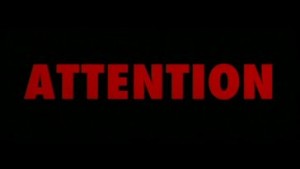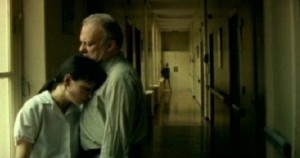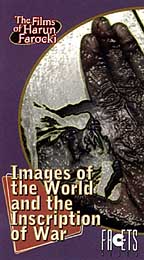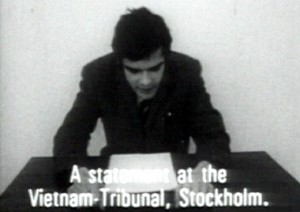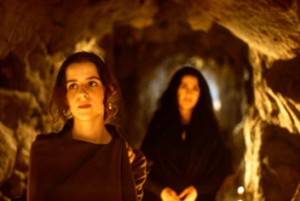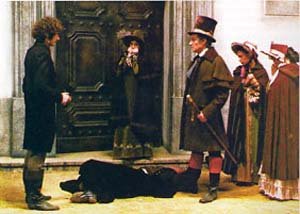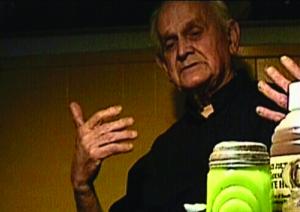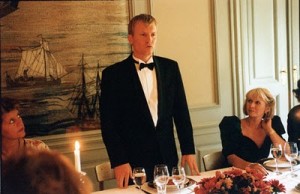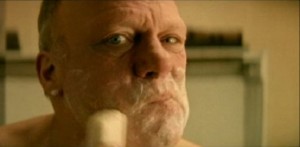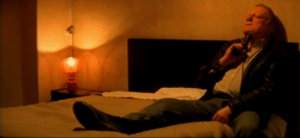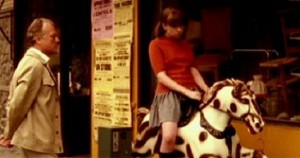Adapted from “Problemes d’accès: Sur les traces de quelque films et cinéastes ‘de festival,’” translated by Jean-Luc Mengus, Trafic no. 30, été 1999. — J.R.
“Festival film”: a mainly pejorative term in the film business, especially in North America. It generally refers to a film destined to be seen by professionals, specialists, or cultists but not by the general public because some of these professionals decide it won’t or can’t be sufficiently profitable to warrant distribution. Whether these professionals are distributors, exhibitors, programmers, publicists, or critics is a secondary issue, particularly because these functions are increasingly viewed today as overlapping, and sometimes even as interchangeable.
The two types of critic one sees at festivals are those (the majority) who want to see the films that will soon be distributed in their own territories, and those who want to see the films that they’ll otherwise never get to see — or in some cases films that may not arrive in their territories for a few years. The first group is apt to be guided in their choices of what to see by distributors, or else by calculated guesses of what distributors will buy. The second group, if it hopes to have any influence, will ultimately seek to persuade potential distributors as well as ordinary spectators, but whether it functions in this way or not, its spirit is generally guided by cinephilia more than by business interests. Because I belong to the second group, I generally prefer as a filmgoer festivals such as Rotterdam and Vienna, where business is kept to a relative minimum, to festivals like Cannes and Berlin, where business of one kind or another becomes the main focus. In recent years, sad to say, Toronto has gradually become more like Cannes and Berlin and less like Rotterdam, and this year Rotterdam was threatening to become a little more like Toronto. (“It’s a different era” is the usual explanation for this gradual change, which expediently eliminates any human agency from the process; if that is the case, part of the continuing attraction of the Viennale is that, like Vienna itself, it remains happily lodged in an earlier era, and the same could be said of Sodankyla in Finland and Torino in Italy.)
Broadly speaking, “festival films” and “festival filmmakers” are like foreign visitors applying for visas in various countries and getting accepted by some, rejected by others. For one reason or another, I attended seven festivals between May 1998 and February 1999 — held respectively in Cannes, Sodankyla, Locarno, Toronto, Vienna, Torino, and Rotterdam. During the same ten months, I also made visits to Providence (October), Ann Arbor (November), and Tokyo (December), tied respectively to events involving de Oliveira, Welles, and Ozu. I attended Cannes for three days in 1998 not as a critic but as a consultant who worked on the recently reconfigured version of Touch of Evil; I saw no films at all, and as it turned out, not even Touch of Evil was screened, but I heard a great deal of talk there about other films long before I saw them at subsequent festivals, so I’ve factored in some of this material as well.
Two filmmakers:
1. Harun Farocki (Locarno). If memory serves, the first Farocki film I ever saw was Images of the World and the Inscription of War at the Berlin Festival in 1989, where it was showing with English subtitles. My difficulties in seeing his films are partly a problem of not speaking German and partly a problem of living in a country that has remained triumphantly pre-Marxist since the thirties. Occasional screenings at the Rotterdam Festival, which I’ve attended for fifteen years, don’t help because they’re seldom shown there with translation in English or French, the only languages I can follow. In the United States. I could see nothing until nine films in a traveling show of eleven surfaced in Chicago in 1991; significantly, the two films omitted were both in 35-millimeter, because no cinema in Chicago and environs with 35mm projection could be found to show them.
This is shocking for a city the size of Chicago, but sadly not surprising. From Machorka-Muff to Moses und Aron, every Straub-Huillet film was shown at the New York Film Festival (a pact broken for political reasons with Fortini-Cani); since then, only Class Relations and From Today Until Tomorrow, and many of the ten others have never shown in the United States at all. As with Farocki, the problems are (a) unavailability of 35mm projection for films of this kind (“this kind” meaning “experimental” in the case of Straub-Huillet, “experimental essays” in the case of Farocki), (b) absence of translation, and (c) absence of a European Marxist tradition: a fatal combination. So the prospect of a substantial Farocki retrospective at Locarno is exciting, especially now that an American “remake” of Farocki’s 1969 Inextinguishable Fire (Jill Godmilow’s What Farocki Taught) is making the rounds, a book coauthored by Farocki in English* is about to appear, and some of Farocki’s work has already come out on video in the United States. At long last, I conclude, it will become possible to catch up properly.
*Speaking About Godard, by Kaja Silverman and Harun Farocki, New York and London: New York University Press, 1998.
Unfortunately, too many other spectators at Locarno feel the same way. Programs are held each morning during the festival’s final week in a small cinema at the Cinecentro Rialto, and the lines to get in are so long that the usual relation of supply to demand has become reversed: whereas many programmers are reluctant to show Farocki films out of fear that no one will come, far too many spectators turn up at the Rialto for everyone to get in. (Fortunately, the same sort of problem doesn’t crop up when I belatedly catch up with the early short films of Jean-Daniel Pollet in Torino.)
It’s like the dilemma of Alice in Alice in Wonderland being either too small or too large to enter a particular space. After missing one morning program as a consequence, I and a few others misbehave and contrive to remain at two consecutive programs the next day in order to avoid the risk of not getting into the second program by standing in line outside, although this ultimately entails seeing both programs without any earphone translation.
In fact, it feels as if the handful of Farocki fans scattered across the globe have suddenly converged into a crushing mob, making it impossible to navigate one’s way from the line outside the cinema to the table with earphones a few paces away. Is this a Marxist or a capitalist problem? Like many things these days, it seems like a diabolical fusion: much as Oliver Stone’s Nixon effectively recreates the monumental self-importance of Stalinist cinema, the mad rushes to see Jean-Marie Straub und Danièle Huillet drehen einen Film nach Franz Kafkas “Amerika” and Peter Lorre in Locarno replicate in miniature the premiere of a Star Wars sequel. I see the first of these films with translation and the second without — meaning that I can understand when Straub directs an actor by making reference to Ricky Nelson in Rio Bravo but can’t follow the nuances of the anti-Hollywood arguments about Lorre’s career.
2. Manoel de Oliveira (Toronto, New York, Chicago, Providence, Tokyo, Rotterdam). I see Inquiètude — for me, possibly de Oliveira’s greatest film since Doomed Love (1978) — twice in Toronto and a third time in Providence at a Portuguese film festival held at Brown University; the only reason I don’t see it a fourth time in Rotterdam is that it’s subtitled in Dutch. Although the one-act play comprising the first episode is about old age, the theme linking all three episodes is existential identity, played out in each case by two characters —father and son, playboy and prostitute, young village woman and ancient witch — who function as parodic mirrors of one another. In its stately, dreamlike rhythms and multiple rhymes it recalls Gertrud, but as the Iranian filmmaker Mehrnaz Saeed-Vafa tells me after she sees it at the Chicago Festival, it also suggests The Arabian Nights.
On one level, I’m amazed that the New York Film Festival doesn’t show the film; one of the members of the selection committee tells me that he considers it “minor” in relation to The Convent and Voyage to Beginning of the World, which the festival did show. But on another level, having served on the selection committee myself for the four previous years, I can easily perceive how the task of seeing a hundred films over two weeks in August could defeat the delicate and at times deceptive operations of a film like Inquiètude; in previous years, masterpieces as important as Kira Muratova’s The Asthenic Syndrome, Edward Yang’s A Brighter Summer Day, and Stanley Kwan’s Actress eluded the committee for what I suspect were comparable reasons. (On the other hand, the fact that the much less selective and influential Chicago Festival shows four times as many films makes its inclusion of Inquiètude, however welcome, less significant.)
As with Luc Moullet and Râùl Ruiz, I owe most of my familiarity with de Oliveira’s work to Rotterdam. The only living master who links the eras of silent and sound cinema, he may well represent what Buñuel calls the “last gasp” (to translate correctly the French title of his autobiography) of a twentieth-century art form if one accepts the recent death warrants of Godard (and ignores Kiarostami and Hou). That is what I find so moving and beautiful about Raymond Bellour’s remarks on de Oliveira’s importance in “Movie Mutations” in Trafic no. 24 and about Frédéric Bonnaud’s essay on Inquiètude in Trafic no. 27, and why I am equally touched, at the conclusion of a symposium about Ozu in Tokyo in December, when Shigehiko Hasumi announces that it coincides with the ninetieth birthday party of de Oliveira in Porto, a gathering he regretfully had to miss in order to stage this event. And that is equally why I decide, two months earlier, to attend four days of a de Oliveira retrospective in Providence, despite the fact that this extended weekend overlaps with the beginning of the Chicago Film Festival and occurs only two days before I move with all my belongings to another apartment in Chicago: generally to resee de Oliveira films that I especially love —Inquiètude, Benilde (as close in a way to Ordet as Inquiètude is to Gertrud), Doomed Love — and to speak about his work at a panel discussion, specifically to see the one major work of his I’ve so far been unable to see, the complete seven-hour version of The Satin Slipper.
But unfortunately, an error in estimating the latter film’s running time, combined with projection problems and a scheduling conflict, means that I and all the other out-of-town guests are obliged to leave for a banquet before the film’s final hour is screened. And the next day, when the four-and-a-half-hour Doomed Love accidentally overlaps with the panel discussion about de Oliveira for similar reasons, the guests are again obliged to leave the film before the end in order to participate. In both cases, it’s a grotesque perversion of academic film study and cinéphilia, as absurd as the difficulties in seeing Farocki’s films in Locarno, though given the ambitiousness of the festival in Providence as a whole — which allows me to resee Benilde and Inquiètude in optimal conditions the two previous nights — I feel caught uneasily between frustration and gratitude. “It’s another era”: with the collapse of public arts funding, events of this kind become harder to organize and bring off properly with every passing year — especially when the prints come from abroad and part of the work is done by volunteers and nonprofessionals — so it’s difficult to know whether to be thankful for the noble attempt or outraged at the various mishaps. Ultimately one feels both emotions, a mixture that all of de Oliveira’s best features are well acquainted with.
Four films and one video:

1. Fear and Loathing in Las Vegas (Sodankyla). Here’s a movie I admire
more than like, mainly because of the unpleasantness of the material, though this is ultimately attributable to the obnoxious Hunter S. Thompson book it’s based on, not to Terry Gilliam and his cowriters. What’s mainly admirable is its unusual fidelity to the period it’s set in (1971) and its imaginative play in the particular zones where Las Vegas tackiness, LSD hallucinations, Gilliam beasties, and lots of vomit become difficult to separate. When I see the film a couple of weeks before it opens in Chicago in May, I judge it to be a healthy provocation for multiplexes even if I don’t much enjoy it. But I find myself enjoying it more a month later when I attend a screening in the Finnish village of Sodankyla at the Festival of the Midnight Sun shortly after a lengthy public interview with Gilliam is conducted by the festival director, Peter von Bagh, in the local schoolhouse. Not really a “festival film” in the sense that the other items in this survey are, it nonetheless takes on different aspects in this informal setting.
What accounts for the difference? The capacity to view Gilliam’s cinema in less conventionally auteurist terms — specifically Gilliam’s account in his interview of how some of his regular coworkers often contribute and encourage the “typical Gilliam touches” that are applauded in his films while he often prefers to strike out in different directions. In other words, the corporate definitions of some studio auteurs such as Gilliam simplify their artistic personalities in order to make them more legible, so that the popular image of Gilliam as megalomaniacal visionary — matching the aggressive sense of entitlement in the hero of Fear and Loathing, Thompson’s stand-in as played by Johnny Depp — is sharply contradicted by Gilliam himself, to all appearances a laid-back hippie. In a comparable way, having gotten to know Samuel Fuller pretty well during the last decade of his life, I find that the snappy aggression of his personality translated better into his corporate auteurist profile than his sweetness and his innocence — which was no less significant a part of his character, but which plays a much smaller role in Fuller criticism. In any case, I can’t say that this clarification transforms Fear and Loathing in Las Vegas into a radically different film, but I can say that it pares away a certain mythology that will allow me to view his future films with fresher eyes.
2. Touch of Evil (Cannes, Toronto, Ann Arbor, Torino, Rotterdam). The reconfiguration of Welles’s film based on forty-eight changes in sound and editing derived from a fifty-eight-page memo that he wrote to Universal studio head Edward Muhl in 1957 is scheduled to premiere in Cannes. But unfortunately this is planned to take place in the smallest auditorium in the Palais for a few hundred VIPs, most of them American. So I’m mainly glad when the spurious claims and legal threats of Welles’s daughter Beatrice persuade Gilles Jacob — who doesn’t have the time while directing the festival to check the facts of the matter — to cancel this screening, which would have entailed excluding most of the world press for the sake of American vanity.
As it turns out, the cancellation gives the film more publicity than it might have had otherwise, thanks mainly to the presence in Cannes of Janet Leigh, editor Walter Murch, picture restorer Bob O’Neil, and producer Rick Schmidlin. In fact, the task of convincing the woman in charge of foreign sales at Universal to show the film abroad has been an uphill battle from the start. Initially she rejected all offers from overseas festivals, and reportedly only after she attended Deauville and Venice did she arrive at the conclusion that people outside the United States might be interested in seeing this version — a good example of the fruits of contemporary American isolationism. (For the same reason, I suspect, most Hollywood studios tend to avoid Cannes premieres because they don’t feel they can gauge the commercial results in advance.)
So the world premiere of the film, which I don’t attend, occurs in Telluride four months later, but I’m around for its second screening shortly afterward in Toronto, along with Leigh and Schmidlin. By this time, the press coverage on the new Touch of Evil has mainly been accurate as well as favorable, and it continues in this vein when the film opens domestically later in September.
In Ann Arbor in October, lecturing in a class taught by Welles scholar Catherine Benamou, I explain how the persistence of Schmidlin and the participation of Murch eventually allowed us to carry out Welles’s instructions without interference, discovering in the process how pertinent and consequential most of these instructions were. (For instance, the removal of a single close-up of Joseph Calleia
from the Hall of Records scene, requested by Welles for cosmetic reasons, actually transforms the character of Menzies from a weakling to a highly principled individual in the final section of the film.) I also illustrate with a video of Murch’s rough cut the two changes I made in his editing decisions — the first one a correction of a simple error (restoring the sound of Sanchez being punched in the stomach by
Quinlan during the long interrogation sequence), the second one a difference of opinion in which Schmidlin ultimately decided in my favor. (The request that Welles devoted the most space to in his memo was to cut the first scene between Leigh and Akim Tamiroff into two segments, cutting back to the scene of the explosion in between; Murch cut this scene into three segments with two cutaways to the explosion scene, and my objection, apart from the fact that Welles didn’t request this, was that it played too smoothly, like the sort of mechanical cross-cutting one finds nowadays in practically every TV cop show. As Welles noted in his memo, this scene “has — and was meant to have — a curious, rather inconclusive quality,” but Murch’s initial fragmentation prevented it from truly functioning as a scene.)
With Murch and Schmidlin in Torino, and then with Schmidlin in Rotterdam, we encounter more technical problems. At the first Torino screening, two of the middle reels get scrambled and then, to the audience’s frustration, the film is screened to the end. (I’m told that one Italian journalist who stayed only for the beginning, as I did,
rushed off to report in his paper the next day that the screening was a resounding success.) Then, in Rotterdam, the film fails to arrive in time for the first screening — scheduled in the largest auditorium at the Pathé (the largest and perhaps best- designed multiplex in Europe), with all the tickets sold — and attracts only a fraction of the same audience when it is subsequently shown twice. But the film has already acquired a Dutch distributor, and by this time Nanni Moretti, the director of Dear Diary and April, has arranged to distribute it in Italy and other European distributors have picked it up, so such mishaps seem less serious than they might have otherwise. I’m more troubled by the fact that Rotterdam’s catalogue and smaller program guide both describe it as a “director’s cut,” suggesting that all the efforts Schmidlin, Murch, Leigh, myself, and others have made to clarify that no such thing as a director’s cut of Touch of Evil can ever exist haven’t successfully crossed the Atlantic. Judging from the August video release of the preview version, it hadn’t even crossed the Universal studio lot six months ago (I speak metaphorically, of course, because a studio’s internal links nowadays are mainly by e-mail), so perhaps it’s myopic to expect that a mainly accurate press coverage in the United States can be exported along with the film. But at least I can correct some of the misunderstandings when I’m interviewed by the festival’s daily newspaper.
3. Dead Cinema (Locarno, Rotterdam). The problem, really, is the existence of ready-made labels for whoever writes ad copy or catalogue descriptions of work that eludes these categories, and the reconfigured Touch of Evil is far from being the only casualty of this situation. Chris Petit’s exciting forty-minute experimental video Dead Cinema, receiving its world premiere in Rotterdam, especially piques my interest because it includes the first sound-and-image interview with critic Manny Farber ever recorded, as well as an interview with art critic Dave Hickey, another favorite of mine. But the fact that the video contains this material can’t be learned from the catalogue, where it’s listed under a working title, Negative Space* — which admittedly offers a clue about Farber’s involvement, being the title of his only book — and is described as follows: “Latest work by the highly productive video essayist Petit, who is rapidly adding substance to the concept of digital aesthetics. A film [sic] about cultural memory, landscape and forgetting, time and television, both in the future and in today’s digital world. England has good, bad and ugly things in store, as is already happening now at the present in the USA.” This is mainly accurate, though it still fails to account for most of the video’s interest.
_________________________________________________________________
*This became the final title a few weeks later, after Petit made a few last-minute changes to the video. See my May 12, 2000 review of this video here.
4. The Celebration (Cannes, Toronto, Rotterdam). This is one of the four new films I hear the most about at Cannes. The other three are Lars von Trier’s The Idiots, Todd Solondz’s Happiness, and Gaspar Noé’s I Stand Alone (see below). The two topics I hear the most about from American critics are the theme of incest in all these films except for The Idiots, and “Dogme 95,” the attention-grabbing manifesto for “natural” filmmaking of von Trier and other Danish filmmakers, in relation to The Celebration and The Idiots. Both these topics are discussed as if they represented the two most important new trends in world cinema. I’m highly skeptical about this — it seems grounded in the same mania for tabloid publicity and the exploitation of American puritanism that made Larry Clark’s Kids the hit of Sundance four years ago — but I’m sufficiently curious to see The Idiots (which I don’t much like) in Paris a few days later, and eventually I catch up with The Celebration and Happiness in Toronto.
In the early eighties, Jonas Mekas recalled to me his difficulties in 1961 in getting The New York Times to publish his manifesto of the New American Cinema; it was suggested that he try the Village Voice instead: “Then I understood, of course, that the only kind of manifesto The New York Times would print would be a press release, not a manifesto at all. In the same way, for an idea to get into the Village Voice today, it has to become not an idea but something else.” Similarly, if Danish filmmakers want to get the attention of the American (and therefore the world) press today they have to write not a press release — everyone writes those now — but a manifesto. Existentially, in other words, the function of “Dogme 95” is to secure an American release for The Celebration and a Hollywood contract for Thomas Vinterberg. For that matter, based on the talk I hear in Cannes, I’m beginning to suspect that the theme of incest is still another way of capturing American press interest — if only because this is logically the only theme left for a press so committed to its own isolationism. (It’s another era.) Even if this sentiment is culturally produced, it’s disturbing that the American conviction that coming from another country can only mean aspiring to be American is matched by some of the recent filmmaking strategies of Europeans.
For me, the winning combination of The Celebration — making it increasingly popular as it proceeds from Cannes to Toronto to Rotterdam — is its combination of punk Ibsen (that is, Ibsen shorn of his politics and his impulse towards social reform, with some of the behavioral rudeness of Strindberg thrown in) with both the theme of incest and an exciting use of the Sony PC7, the smallest digital video camera available to Vinterberg at the time of shooting. None of these elements has much to do with the ten rules of “Dogme 95”’s alleged “Vow of Chastity”; if anything, the mistrust of high-tech filmmaking techniques reflected in that manifesto is contradicted by the exciting uses made of the Sony PC7. In fact, the film’s plot and style are both based on deceptions. What appears to be the out-of-control behavior of the central character (Ulrich Thomsen) at a family gathering is in fact a series of carefully staged events, planned with the complicity of the kitchen staff. And what appears to be an out-of-control recording of this behavior is in fact a model of careful exposition — counteracting the continuity of the plot with as much discontinuity as can be managed without losing the threads of the action, executed with the full cooperation of camera crew and editing assistants. If it’s a form of coquetry for Vinterberg to leave his name off the credits when he knows that we’ll know it anyway, it’s a similarly ironic subterfuge to use the dubious principles of “Dogme 95” to discipline his artistic choices as well as liberate them.
5. I Stand Alone (Cannes, Toronto, New York, Rotterdam). I have only the dimmest recollection of Gaspar Noé’s Carne (1991) except that I didn’t much like it, so when I hear widely disparate responses to his first full-length feature at Cannes this year, I’m not very interested, and I don’t encounter the film until I idly ask to see it on video at the videothèque in Rotterdam almost nine months later. A particular reason why I’ve been in no hurry to see the film is the enthusiasm for it displayed by one of my least favorite American critics, who was one of the leading champions of Kids, and who subsequently describes I Stand Alone in print as having (I quote from memory) “the most redemptive ending of any film since Robert Bresson’s Pickpocket” — a piece of hyperbole that conjures up the surrealist image of a redemption sweepstakes in which all potentially redemptive films since Pickpocket leave the starting gate at the same time and only one, in keeping with the spirit of American competition, is declared the winner. (In general, the use of the word “redemptive” is for me already a danger signal because, in a contemporary context, this usually means an extravagant bloodbath from the likes of Scorsese, Schrader, or Tarantino.) Apart from this dubious accolade, my colleagues mainly seem to agree only on how unpleasant it is, some of them taking exception to the political implications of Noé’s own assertions about the film, though the film still surfaces with a certain amount of fanfare at the festivals in Toronto and New York.
“What would Sam Fuller make of this film?” is one of the questions that intrigues me the most while watching it. The timing of individual cuts to plucked strings on the sound track, then subsequently to off-screen gunshots, remind me of both the opening sequence of Fuller’s Verboten and the linking intertitles with gunshots in Godard’s Masculin-Féminin, though the violent changes of camera angle that
often accompany these jolts are even more visceral. Following the bleak descent into rage and violence of a former butcher and convict (the same character in Carne, I faintly recall) who narrates his own progress with abusive, xenophobic language and murderous fantasies, the film offers images of downtrodden humanity that go beyond those of The Honeymoon Killers (not to mention those of Darejan Omirbaev’s Killer), and a Monsieur Verdoux without a trace of charm or allegiance
to any family, equipped with a mouth like Céline’s as updated by partisans of Le Pen; the fact that the hero is the son of a Communist partisan killed by Nazis only adds to the troubling mix.
But the excitement of this film, fueled by the joint I smoked an hour earlier, is not merely a function of its odious material but its formal manner of implicating the viewer — light-years away from the glib Woody Allen attitudes of Happiness, the sub-Cassavetes manner (and prepolitical rebellion) of The Idiots, and even the more adventurous style of The Celebration. Overall, the film’s evolution from short segments to extended scenes resembles the otherwise radically different Rushmore of Wes Anderson, a form of construction that builds on the solicitation of the viewer’s trust and involvement so that long scenes are arrived at only after they’re emotionally and dramatically earned. By the time the film arrives at its alternate endings involving incest with the protagonist’s emotionally disturbed daughter, murder, and/or suicide — effectively obliging me to select which ending I prefer, “happy” or “unhappy” — I feel I’m watching a remake of Taxi Driver by Alain Robbe-Grillet, but crucially a remake in which none of the racist or homophobic epithets get displaced to characters other than the hero, and finally a Brechtian unpacking of fascist rage that shakes me to my core. I suspect it’s fortunate that, even while I’m writing this, I’ve encountered none of Noé’s discourse about the film, apart from the intriguing information that he originally wanted to call it France, and the fact that I watch (and, a few days later, resample) it alone on video, matching my own isolation with that of the hero, undoubtedly purifies my encounter with the material as well.
It’s true that I’m only seeing it on video, but it’s also part of the progressive shrinkage of film culture that such a fact begins to seem secondary. In the somewhat sloppy Rotterdam catalogue, as noted above, Chris Petit’s video Dead Cinema is described as a film, and no mention is made of Farber. Calling a video a film is something most film professors in the United States habitually do as well nowadays, simply because they can’t afford to book 16-millimeter prints for their courses and haven’t yet read Serge Daney, most of whose writings about movies on TV have yet to be translated. And after I Stand Alone has a limited run in the United States later this year — given the size of its distributor, one can’t expect any more — it will undoubtedly be known there mainly on video. “It’s another era,” my friends say, and one in which rumors about films and filmmakers often take the place of news. But the nice thing about rumors is that they’re most often carried by friends rather than by publicists.

